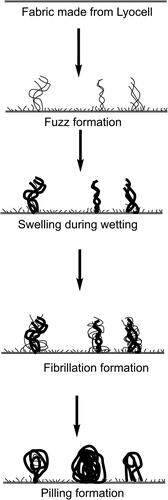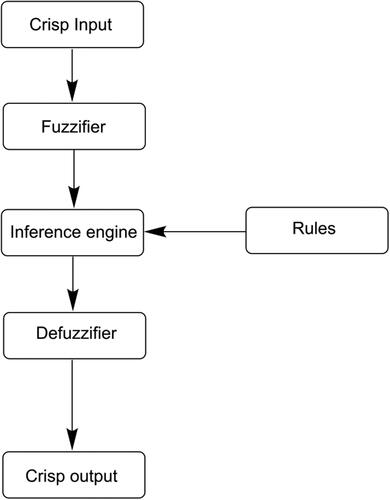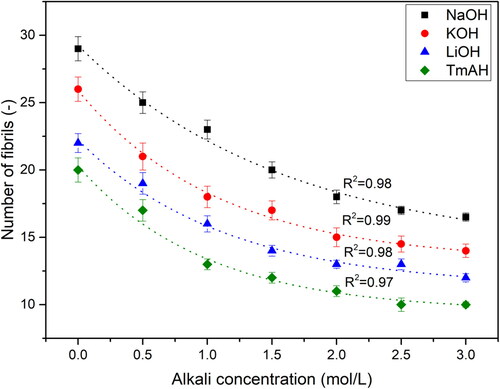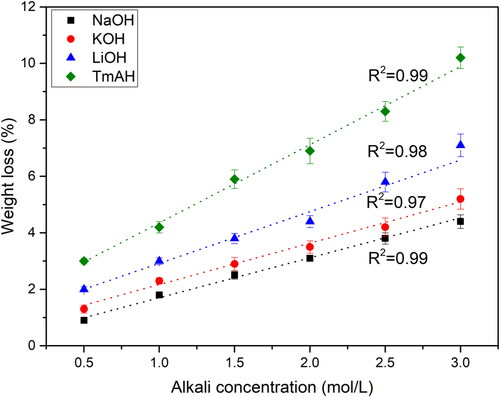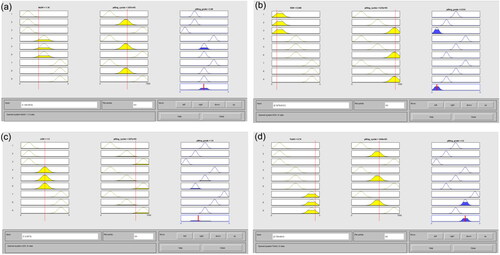 ?Mathematical formulae have been encoded as MathML and are displayed in this HTML version using MathJax in order to improve their display. Uncheck the box to turn MathJax off. This feature requires Javascript. Click on a formula to zoom.
?Mathematical formulae have been encoded as MathML and are displayed in this HTML version using MathJax in order to improve their display. Uncheck the box to turn MathJax off. This feature requires Javascript. Click on a formula to zoom.Abstract
Fabric pilling is formed due to the entanglement of fibers during mechanical actions including abrasion, domestic washing process, and wearing cycles. Pilling resistance is one of the important aesthetic property of fabrics controlling the appearance of fabric quality. Pilling can be controlled by different methods; alkali treatment is one of the methods for the lyocell fabric. In this study, the prediction of pilling resistance on the alkali treated lyocell fabric has been done through a fuzzy inference system (FIS). In general, conventional pilling measurements has some hindrance due to human error and time consuming. This work utilizes the algorithm to provide accurate quantitative values of pilling grades. The correlation coefficient ‘r’ between predicted and experimental values shows 0.93 for TmAH and 0.81 for NaOH treatments. The forecast between experimental and predicted data sets of pilling grades were evaluated by mean absolute percentage error (MAPE) method and observed the values for NaOH, KOH, LiOH, and TmAH treatments as 16.6%, 18.87%, 21.09%, and 8.72% respectively.
1. Introduction
Currently, there is a huge demand for renewable, sustainable, biodegradable cellulosic textile fibers as it has several advantages over synthetic textile fibers. Lyocell is a unique biodegradable, regenerated fiber derived from sustainable cellulose with the help of organic solvent NMMO (White et al., Citation2005). As a structural concern, lyocell consists of approximately 80% crystalline cellulose-II and amorphous regions (Abu-Rous, Citation2006). The degree of crystallinity in lyocell is much higher than popular regenerated cellulosic fibers such as modal (49%) and viscose rayon (41%) (Kreze et al., Citation2001; Kreze & Malej, Citation2003). Lyocell fibers have thinnest and longest crystallites, even the amorphous regions are well oriented with the fiber axis (Carrillo et al., Citation2004). Due to the higher orientation in nature, lyocell has a higher degree of crystallinity leading to higher wet/dry tenacity, high wet modulus (Goswami et al., 2009). Contrarily, lyocell has a major disadvantage as it forms fibrillation during wet conditions (Kreze & Malej, Citation2003). In short, weaker cross-links between the crystallites and higher orientation of the lyocell fibers entail the local separation of microfibers (i.e. longitudinal splitting) during mechanical action under wet conditions is known as fibrillation; it is approximately 1-4 μm in diameter (Goswami et al., Citation2009). On other side, fibrillation can produce a peach skin effect (Goswami et al., Citation2007), however, it is not a long-lasting effect since the appearance could be spoiled due to the formation of pilling. Pilling is a phenomenon exhibited by fabrics formed due to the entanglement of fibers on fabric surfaces during wear or laundering. Generally, fabric with pills displays an unattractive appearance (Xu, Citation1997).
The mechanism of pilling tendency from lyocell fabric has been well explained from our previous work (Hajilari et al., Citation2009; Periyasamy, Citation2012), further the proposed mechanism for pill generation is given in . The fuzz formation is the first stage of pilling generations, whereas fibrillation is the first stage for fuzz formation (Baird et al., Citation1956; Okubayashi & Bechtold, Citation2005). Alkali pretreatment is one among many methods in controlling fibrillation formation, enzymatic treatment also associated with the reduction of pilling generation (Esfandiari et al., 2014).
Zadeh recommended the fuzzy mathematical set theory (Zadeh, Citation1965). FIS has a multi-valued logic structure as artificial intelligence (AI) whereas the execution is simple to other versions. It has the capability to operate in enough quantity of speculative information in non-linear, trial-error, and indistinct domains. Additionally, this framework is cost-effective and modest in the application (Hossain et al., Citation2016). Fundamentally FIS contains four major modules (Madu, Citation2012) which are shown in .
Several researchers have studied the application of fuzzy information system in textiles, particularly on predicting the yarn strength (Hossain et al., Citation2016) weaving operation (Dayik et al., Citation2008), modeling of UV protection factor (Hatua et al., Citation2014), mechanical properties (Hossain et al., Citation2016), EMI shielding (Wang et al., Citation2017), modeling of decolorization of textile dye solution containing C.I. Basic Yellow 28 by electrocoagulation process (Daneshvar et al., Citation2006), wrinkle recovery (Hussain et al., Citation2015), textile sensor (Vu & Kim, Citation2018), and fibrous microplastic emission (Muthusamy et al., Citation2022; Periyasamy, Citation2021). In pilling resistance, there are certain works carried out (Lee & Lin, Citation2018; Saharkhiz & Abdorazaghi, Citation2012; Yan et al., Citation2016). However, there is no report on the prediction of pilling grade on lyocell fabric by varying the alkali pre-treatment and their influences. Hence it is considered in the current study. In this work, the prediction of the pilling tendency of lyocell fabric with the influence of different alkalis with various concentrations (i.e. 0.5 to 3 mol/L) and different pilling cycles (125 to 7000 cycles) are discussed. For better understanding, we discussed the fibrillation numbers and weight loss upon the alkali pre-treatments. However, the prediction model does not include the fibrillation numbers and weight loss as it is beyond the scope of this present work.
2. Experimental methods
2.1. Materials
100% Lyocell knitted fabric (255 g.m−2; single jersey structure with the linear density of course 135 denier and wales 135 denier) was used in this work and it is purchased from the local industry at Tirupur, India. For the alkali pre-treatment, four different alkalis such as sodium hydroxide (NaOH), potassium hydroxide (KOH), lithium hydroxide (LiOH), tetramethylammonium hydroxide (TmAH) purchased from Sigma Aldrich- India, were used.
2.2. Alkali pretreatments
Alkali treatment for lyocell fabrics (300 mm X 300 mm) is carried out in a simple pad-batch process where the fabric is immersed in the alkali-containing solution for 30 min and padded with the constant nip pressure (1 bar) and speed (1 m/min). For the treatment, varied concentration levels (0.5, 1, 1.5, 2, 2.5 3 mol/L) of four different alkalis were used at room temperature. After the padding process, the fabric was rolled on the glass rod and covered with polypropylene sheets, and kept 4 h at room temperature. Later, it was rinsed with hot water, neutralized with acetic acid, further washed with cold water, and finally dried in atmospheric conditions.
2.3. Characterization
The surface morphology of alkali treated lyocell knitted fabric was observed under the scanning electron microscope (SEM) (VEGA TESCAN Inc. USA) at 20 kV. For the measurement of fibril number per unit area, yarns are withdrawn from different parts of the fabric, later, fibers were extracted to analyze the fibrils per unit area by using an optical microscope within a range of 380 µm longitudinal length. 30 fibers were examined separately, and the mean value is calculated for further studies (Zhang et al., Citation2005b, Citation2005a). The weight loss percentage on the alkali-treated fabric can be calculated using the following equation.
(1)
(1)
where WD = initial dry mass of fiber specimens (g) and WP = dry mass of fibers (g) after alkali treatment and neutralization.
2.4. Pilling assessment
Martindale pilling and abrasion tester were used to access the pilling propensity of alkali-treated lyocell fabric according to the ISO 12945-2:2000 (Modified Martindale method). Prior to the measurement, the fabric has been conditioned according to the TS EN ISO 139 standard. The samples were cut into 150 mm × 150 mm pieces and rubbed on the Martindale pilling and abrasion tester (MESDAN-LAB, Italy) for 125, 500, 1000, 2000, 5000, and 7000 rubs (herein denoted as “pilling cycle”). The standards for the pilling ratings (i.e. grade) on the fabric can be described as “5 referring no change or no pilling, 4 refers to slight pilling, 3 for moderate pilling, 2 for severe pilling and 1 is very severe pilling”. After each specific rubs, the fabric was compared with ASTM pill grade photographic image in the viewing cabinet (datacolor, USA) and concluded the pilling grades by three experienced observers. These assessments were done five times and the mean values of the results were recorded.
2.5. Development of fuzzy prediction model for the pilling grade
The proposed fuzzy prediction model of accessing the pilling grade was developed by using fuzzy logic toolbox in MATLAB (version-2020). demonstrates the FIS system with five basic steps of calculations.
2.5.1. Formulation of input/output membership function
For the fuzzy prediction model of the pilling assessment, the process variables such as alkali concentrations (i.e. 0.5, 1, 1.5, 2, 2.5, and 3 mol/L) and pilling cycles (125, 500, 1000, 2000, 5000, and 7000) were used as crisp input data and pilling grade was used as a crisp output data for the alkali-treated lyocell fabrics.
For the process of fuzzification, three linguistic fuzzy sets were implemented for the input variables (i.e. alkali concentrations and pilling cycles) namely low, medium, and high. For the output variable five linguistic fuzzy sets were implemented namely I- very severe pilling, II- severe pilling, III-moderate pilling, IV- slight pilling, and V- no pilling (according to the ASTM standard). The input and output variables were entirely concealed appropriately with these linguistic fuzzy sets of alkali-treated lyocell fabric. The input and output fuzzy sets for input-output parameters are displayed in .
Table 1. The input and output fuzzy sets for input-output parameters for this work.
For this fuzzy prediction model, the gaussian membership function for the fuzzy variables (i.e. alkali concentrations and various levels of pilling cycles) has been defined by a central value m, and a standard deviation k > 0 is given by EquationEq. (2)(2)
(2) .
(2)
(2)
In general, the gaussian membership function was chosen to provide a more continuous transition from one interval to another and hence providing a smoother surface from the fuzzy rules whereas the triangular membership function does not possess these abilities.
The defuzzification (EquationEq. 3(3)
(3) ) of output variables to crisp pilling grade is carried out by centroid defuzzification methodology.
(3)
(3)
where
is the membership function.
2.5.2. Fuzzy rule formation
In this prediction model, a total of 9 rules per alkali treatment on pilling cycles were formulated for the input and output variables. The relationship between the input and output variables is displayed in which represents the base for the fuzzy rules. The relationship is defined as “IF ‘NaOH concentration’ is ‘LOW’ AND the ‘Pilling cycle’ is ‘LOW’ THEN the ‘pilling grade’ is ‘II-Severe pilling’”. Similarly, the base rules are defined to other alkalis under Mamdani interference systems are used in this study and to their concentrations. Mamdani interference systems are adorable to grasp and their intuitive nature is well suited to the expert system application whereas all the base rules are generated from human expert knowledge.
Table 2. Fuzzy base rules.
2.5.3. Model evaluation
The following criterion was applied to assess the quality of the prediction model. The performance of forecasting data sets can be determined by using MAPE method (EquationEq. 4(4)
(4) ) (Kim & Kim, Citation2016). It is easy to interpret as compared to other methods such as mean squared error (“Mean Absolute Percentage Error (Mape),” 2006).
(4)
(4)
where At is the actual value (i.e. experimental value) and Ft is the forecast value.
3. Results and discussion
3.1. Effect of alkali treatment on fibril numbers
The relation between fibril numbers as well as alkali treatment is shown in . The alkali concentration is inversely proportional to the fibril numbers as this trend is observed for all alkalis. Moderately, TmAH demonstrates the highest reduction of the fibril numbers than other alkalis used for this work, 10 fibrils were observed with the concentration of 3 mol/L (i.e. the pristine fabric reveals 29 fibrils per specified size). The number of fibrils is inversely proportional to the concentration of the alkali up to 2 mol/L and thereafter there is no significant difference in the reduction. The results suggest that depending on the swollen state of the polymer tends to the fibrillation of lyocell fibers (Periyasamy, Citation2012; Periyasamy et al., Citation2011a, Citation2011b). The fibers treated with alkali reach a plasticization state for both inter-and intra-molecular hydrogen bonds, henceforth tending to reduce the fibrillation tendency during the state of plasticization, which ensures the reduction of pilling tendency, and it can be seen in .
3.2. Effect of alkali treatment on weight loss
The weight loss percentage of lyocell fabric after alkali treatment is shown in . The alkali treatments dissolve the polymer chain, specifically on short-length chains and hemicelluloses31 which causes weight loss on the fibers resulting in polymer destruction. Consequently, these short-chain lengths undergo oxidative degradation cause a huge percentage of carboxyl groups in lyocell throughout the treatment, at the same time, the dissolution of chain-length which are short may initiate the reduction of the carboxyl content throughout the alkali treatment (Ibbet et al., Citation2006; Ibbett & Hsieh, Citation2001). The weight loss result is directly proportional to the concentration of alkali. TmAH, and LiOH show a maximum weight-loss percentage than other alkalis in all the concentrations, resulting in faster swelling and infiltration of these alkalis than NaOH and KOH. Nonetheless, maximum weight loss occurs during the TmAH treatment at 3 mol/L due to greater swelling causing damages to the fiber.
3.3. Linguistic rules of the fuzzy prediction model
The implication of fuzzy rules elicited by the FIS is shown in . On this occasion, only one fuzzy rule is shown and explained in each concentration and pilling cycle for each alkali. When the alkali concentration (NaOH) is medium (i.e. 1.159 mol/L) and the pilling cycle is medium (3972) then the predicted pilling grade is 2.46 (according to ASTM standard, it is assumed that severe pilling to moderate pilling). As the KOH concentration is chosen to be LOW (i.e. 0.308) and the pilling cycle to be high (6331) then the predicted pilling grade is 0.514 (according to ASTM standard it is assumed that very severe pilling). For LiOH, the predicted pilling grade is 1.8 (according to ASTM standard it is assumed that severe pilling) when the medium concentration (i.e. 1.5 mol/L) and high pilling grade (5073). For TmAH, high concentration of 2.74 with a 4041 medium pilling cycle, the predicted pilling grade is obtained as 3.5 (according to ASTM standard it is assumed that moderate pilling to slight pilling).
3.4. Effect of alkali treatment and pilling cycles on pilling grade
As discussed in section 1, the fabric made from lyocell fibers has more possibilities for pilling formations due to the inbuild fiber characteristics of fuzz/fibrillation formations. By implementing the Mamdani inference system, the centroid method for defuzzification, and the rules based on 9 linguistic propositions for different alkalis (NaOH, KOH, LiOH, and TmAH), we get the surface given in respectively as a solution of the fuzzy system. The surface plots describe the influence of alkali treatment on the pilling formations, the pilling grade is increased with increasing concentration of alkalis, and however, it varies with respect to the type of alkalis used.
Results show that there is no significant pilling resistance until 1 mol/L of NaOH treatment at lower pilling cycles, the pill formation occurs as the pilling cycle increases to 7000 even in a higher concentration of NaOH treatment (). KOH with 3 mol/L at 125 pilling cycle, it is observed that moderate pilling resistance whereas it shows severe pill formation as the pilling cycle increases to 7000 cycles (i.e. the pilling grade is 2, see ). When the lyocell fabric is treated with LiOH, it shows significant improvement in the pilling resistance. LiOH with 0.5 mol/L concentration at 125 pilling cycle shows moderate pilling resistance whereas the same samples undergone above 5000 pilling cycle shows severe to moderate pilling grade (). The pilling resistance of lyocell fabric pre-treated with TmAH is shown in . For a concentration of 0.5 mol/L, the resistance of pilling is slight during 125 cycles whereas the same sample provides very severe to moderate pilling for the 7000 pilling cycles. The sample treated with TmAH enhanced resistance to the pilling as compared to that of other alkalis used for this work. The pilling resistance of the alkali-treated fabric is as follows; TmAH > LiOH > KOH > NaOH.
Pilling resistance depicts significant improvement until 2000 cycles, beyond this there is no significant improvement even though it is processed with the same treatment. Besides, alkali concentration plays a vital role in the process of pilling reduction due to its fiber’s rigidity and brittleness. It can be visible in the scanning electron microscopic results which are given in . It can be seen clearly that the protruding fibers with free surface (i.e. which is pulled out easily due to the alkali treatments). Additionally, abrasion forces act on the fabric surface by removing the fuzz and pill formed. provides the digital images of untreated and different alkali pre-treated lyocell knitted fabric with a pilling cycle of 500.
Figure 7. Surface images of untreated fabric (a); treated with NaOH 3 mol/L (b); KOH 3 mol/L (c); LiOH 3 mol/L (d); TmAH 3 mol/L (e).
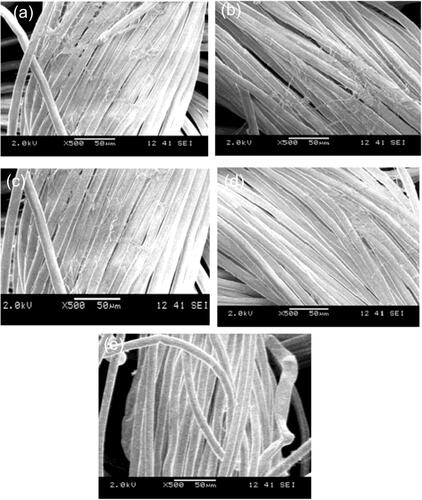
Figure 8. Surface plot explaining the influence of NaOH concentration and pilling cycles on pilling grade.
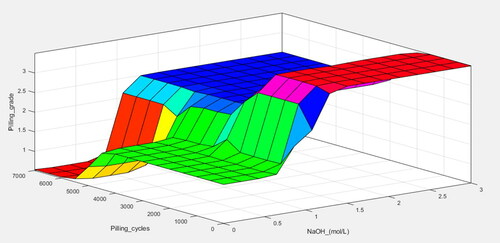
Figure 9. Surface plot explaining the influence of KOH concentration and pilling cycles on pilling grade.
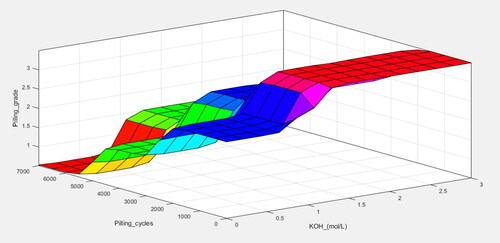
Figure 10. Surface plot explaining the influence of LiOH concentration and pilling cycles on pilling grade.
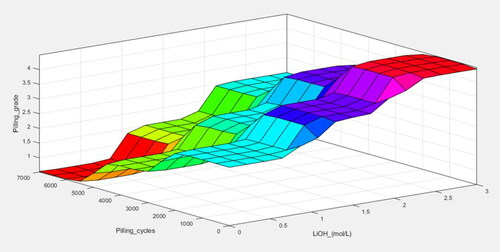
Figure 11. Surface plot explaining the influence of TmAH concentration and pilling cycles on pilling grade.
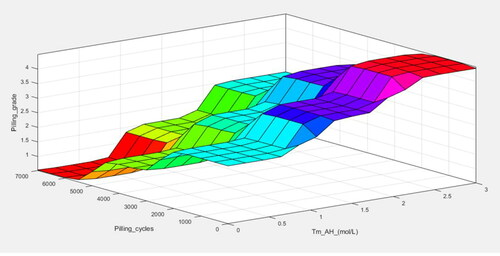
Figure 12. Surface images of untreated lyocell fabric after 500 cycles of pilling measurement (a); 500 cycles of fabric treated with NaOH 3 mol/L (b); 500 cycles of fabric treated with KOH 3 mol/L (c); 500 cycles of fabric treated with LiOH 3 mol/L (d); 500 cycles of fabric treated with TmAH 3 mol/L (e).
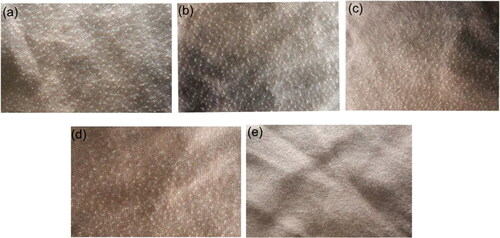
3.5. Affirmation of FIS performance
To find the performance of FIS systems, it is required to compare the predicted and the actual experimental value which is shown in . Pearson correlation coefficients (r) were calculated to interpret both experimental and predicted data sets of pilling grades. The Pearson ‘r’ value is varied depending upon the type of alkali pre-treatment, TmAH provides a higher ‘r’ value (0.93) among the four alkalis and similarly, NaOH with the lowest ‘r’ value (0.81). Generally, the correlation coefficient reflects the strength of the relationship between experimental data and predicted data. KOH, LiOH, and TmAH provide a strong relationship that is, in general when ‘r > 80′ is referred to as a strong relation (Taylor, Citation1990) between the predicted and experimental data of pilling grade. For accurate forecast between the experimental and predicted data sets of pilling grades, MAPE method was used and observed values for NaOH, KOH, LiOH, and TmAH treatments were 16.6%, 18.87%, 21.09%, and 8.72% respectively (). The prediction performance of the models deteriorates when they are presented with unseen testing data. These results underline that the prediction performance of FIS model is better.
Figure 13. Correlation between experimental and predicted values of pilling grade, NaOH (a); KOH (b); LiOH (c); TmAH (d).
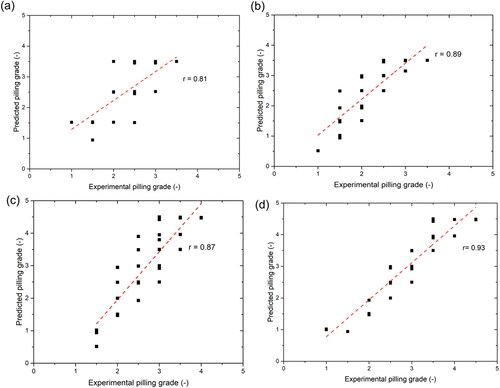
Table 3. Influence of pilling cycle and alkali concentration on MAPE.
4. Conclusion
Lyocell fabric has been pretreated with four different alkalis to study their influence on the pilling resistance and the study further determines to predict the pilling resistance by using of FIS model. Herein, two process parameters (alkali concentrations, pilling measurement cycle) as used as input variables and the pilling grade as an output variable. Fabric treated with TmAH treatment shows significant reduction of fibril numbers in contrast increase the weight loss as compared to other alkali pretreatment. Higher pilling grades can be achieved by alkali-treated lyocell fabric concerning their surface texture with a high degree of correlation with the conventional method of pilling measurement.
The prediction model performance has been found to be good as the correlation coefficient ‘r’ between experimental and predicted shows more than 0.8 (i.e. for all alkalis) and the MAPE is lower than 22% in testing data sets. In particular, the main advantage of FIS model is having the capability to interpret between the process parameters (i.e. alkali concentration). Consequently, the great outcomes of the suggested system are promising for the approach expansion to the fabric pilling measurement and not just for the alkali pretreated fabrics, likewise include different fabric types. Overall, FIS model can predict different tuning results by modifying the input parameters, number of membership functions, types of membership functions, tuning iteration and optimization method.
Declaration of interests
The authors declare that they have no known competing financial interests or personal relationships that could have appeared to influence the work reported in this paper.
Disclosure statement
No potential conflict of interest was reported by the authors.
References
- Abu-Rous, M. (2006). Characterization of the wet-state pore structure of lyocell and other man-made cellulosic fibers by fluorescence and electron microscopy. University of Innsbruck.
- Baird, M. E., Hatfield, P., & Morris, G. J. (1956). Pilling of fabrics. Journal of the Textile Institute Transactions, 47(4), T181–T201. https://doi.org/10.1080/19447027.1956.10750392
- Carrillo, F., Colom, X., Suñol, J. J., & Saurina, J. (2004). Structural FTIR analysis and thermal characterisation of lyocell and viscose-type fibres. European Polymer Journal, 40(9), 2229–2234. https://doi.org/10.1016/j.eurpolymj.2004.05.003
- Daneshvar, N., Khataee, A. R., & Djafarzadeh, N. (2006). The use of artificial neural networks (ANN) for modeling of decolorization of textile dye solution containing C. I. Basic Yellow 28 by electrocoagulation process. Journal of Hazardous Materials, 137(3), 1788–1795. https://doi.org/10.1016/j.jhazmat.2006.05.042
- Dayik, M., Kayacan, M. C., Acar, M., & Çaliş, H. (2008). Modeling of warp tension variation during shedding operation using fuzzy logic. Journal of the Textile Institute, 99(6), 505–514. https://doi.org/10.1080/00405000701608359
- Esfandiari, A., Firouzi-Pouyaei, E., & Aghaei-Meibodi, P. (2014). Effect of enzymatic and mechanical treatment on combined desizing and bio-polishing of cotton fabrics. Journal of Textile Institute, 105(11), 1193–1202.
- Goswami, P., Blackburn, R. S., El-Dessouky, H. M., Taylor, J., & White, P. (2009). Effect of sodium hydroxide pre-treatment on the optical and structural properties of lyocell. European Polymer Journal, 45(2), 455–465. https://doi.org/10.1016/j.eurpolymj.2008.10.030
- Goswami, P., Blackburn, R. S., Taylor, J., Westland, S., & White, P. (2007). Dyeing behaviour of lyocell fabric: Effect of fibrillation. Coloration Technology, 123(6), 387–393. https://doi.org/10.1111/j.1478-4408.2007.00113.x
- Hajilari, M., Esfandiari, A. H., Dabiryan, H., & Gharbi, S. H. M. P. (2009). Investigation of effect of fibres modulus on pilling of acrylic fabrics. Journal of the Textile Institute, 100(2), 135–140. https://doi.org/10.1080/00405000701679681
- Hatua, P., Majumdar, A., & Das, A. (2014). Modeling ultraviolet protection factor of polyester-cotton blended woven fabrics using soft computing approaches. Journal of Engineered Fibers and Fabrics, 9(3), 155892501400900. https://doi.org/10.1177/155892501400900311
- Hossain, I., Choudhury, I. A., Mamat, A. b., Shahid, A., Khan, A. N., & Hossain, A. (2016). Predicting the mechanical properties of viscose/lycra knitted fabrics using fuzzy technique. Advances in Fuzzy Systems, 2016, 1–9. https://doi.org/10.1155/2016/3632895
- Hussain, T., Malik, Z. A., Arshad, Z., & Nazir, A. (2015). Comparison of artificial neural network and adaptive neuro-fuzzy inference system for predicting the wrinkle recovery of woven fabrics. The Journal of the Textile Institute, 106(9), 934–938. https://doi.org/10.1080/00405000.2014.953790
- Ibbet, R. N., Phillips, D. A. S., & Kaenthong, S. (2006). Evaluation of a dye isotherm method for characterisation of the wet-state structure and properties of lyocell fibre. Dyes and Pigments, 71(3), 168–177. https://doi.org/10.1016/j.dyepig.2005.06.010
- Ibbett, R. N., & Hsieh, Y.-L. (2001). Effect of fiber swelling on the structure of lyocell fabrics. Textile Research Journal, 71(2), 164–173. https://doi.org/10.1177/004051750107100212
- Kim, S., & Kim, H. (2016). A new metric of absolute percentage error for intermittent demand forecasts. International Journal of Forecasting, 32(3), 669–679. https://doi.org/10.1016/j.ijforecast.2015.12.003
- Kreze, T., & Malej, S. (2003). Structural characteristics of new and conventional regenerated cellulosic fibers. Textile Research Journal, 73(8), 675–684. https://doi.org/10.1177/004051750307300804
- Kreze, T., Stana-Kleinschek, K., & Ribitsch, V. (2001). The sorption behaviour of cellulose fibres. Lenzinger Berichte, 80, 28–33.
- Lee, C.-L., & Lin, C.-J. (2018). Integrated computer vision and type-2 fuzzy CMAC model for classifying pilling of knitted fabric. Electronics, 7(12), 367. https://doi.org/10.3390/electronics7120367
- Madu, G. (2012). Digital control and state variable methods: Conventional and intelligent control systems (4th ed.). Tata McGraw Hill Education Pte. Ltd.
- Mean Absolute Percentage Error (Mape). (2006). Encyclopedia of production and manufacturing management (pp. 462–462). Springer US. https://doi.org/10.1007/1-4020-0612-8_580
- Muthusamy, L. P., Periyasamy, A. P., Militký, J., & Palani, R. (2022). Adaptive neuro-fuzzy inference system to predict the release of microplastic fibers during domestic washing. Journal of Testing and Evaluation, 50(1), 20210175. https://doi.org/10.1520/JTE20210175
- Okubayashi, S., & Bechtold, T. (2005). Alkali uptake and swelling behavior of lyocell fiber and their effects on crosslinking reaction. Cellulose, 12(5), 459–467. https://doi.org/10.1007/s10570-005-2204-1
- Periyasamy, A. P. (2012). Effect of alkali pretreatment and dyeing on fibrillation properties of lyocell fiber. In RMUTP International Conference: Textiles & Fashion 2012 (pp. 1–11). http://decade1.ird.rmutp.ac.th/wp-content/uploads/2012/09/Section-II-3.pdf
- Periyasamy, A. P. (2021). Evaluation of microfiber release from jeans: The impact of different washing conditions. Environmental Science and Pollution Research International, 28(41), 58570–58582. https://doi.org/10.1007/s11356-021-14761-1
- Periyasamy, A. P., Dhurai, B., & Thangamani, K. (2011a). A study on fibrillation properties of Lyocell fiber. Colourage, 58(1), 45–48.
- Periyasamy, A. P., Dhurai, B., & Thangamani, K. (2011b). Salt-free dyeing - a new method of dyeing on lyocell/cotton blended fabrics with reactive dyes. Autex Research Journal, 11(1), 14–17.
- Saharkhiz, S., & Abdorazaghi, M. (2012). The performance of different clustering methods in the objective assessment of fabric pilling. Journal of Engineered Fibers and Fabrics, 7(4), 155892501200700. https://doi.org/10.1177/155892501200700413
- Taylor, R. (1990). Interpretation of the correlation coefficient: A basic review. Journal of Diagnostic Medical Sonography, 6(1), 35–39. https://doi.org/10.1177/875647939000600106
- Vu, C. C., & Kim, J. (2018). Human motion recognition using SWCNT textile sensor and fuzzy inference system based smart wearable. Sensors and Actuators A: Physical, 283, 263–272. https://doi.org/10.1016/j.sna.2018.10.005
- Wang, S., Zhang, T., Cheng, L., Li, J., Tang, H., & Guo, M. (2017). Comprehensive performance of compound fabrics in terms of electromagnetic shielding and wearability based on the Euclid approach degree of fuzzy matter elements. The Journal of the Textile Institute, 108(3), 341–346. https://doi.org/10.1080/00405000.2016.1166820
- White, P., Hayhurst, M., Taylor, J., & Slater, A. (2005). Lyocell fibres. In R.S. Blackburn (Ed.), Biodegradable and sustainable fibres (pp. 157–190). Woodhead Publishing Limited and CRC Press. https://doi.org/10.1533/9781845690991.157
- Xu, B. (1997). Instrumental evaluation of fabric pilling. The Journal of the Textile Institute, 88(4), 488–500. https://doi.org/10.1080/00405000.1997.11090899
- Yan, Y., Wu, J., Jin, Z., & Tao, J. (2016). Performance research of knitted hemp fabric and fuzzy comprehensive evaluation [Paper presentation].2016 9th International Symposium on Computational Intelligence and Design (ISCID) (pp. 174–177). https://doi.org/10.1109/ISCID.2016.1047
- Zadeh, L. A. (1965). Fuzzy sets. Information and Control, 8(3), 338–353. https://doi.org/10.1016/S0019-9958(65)90241-X
- Zhang, W., Okubayashi, S., & Bechtold, T. (2005a). Fibrillation tendency of cellulosic fibers. Part 1: Effects of swelling. Cellulose, 12(3), 267–273. https://doi.org/10.1007/s10570-004-2786-z
- Zhang, W., Okubayashi, S., & Bechtold, T. (2005b). Fibrillation tendency of cellulosic fibers. Part 2: Effects of temperature. Cellulose, 12(3), 275–279. https://doi.org/10.1007/s10570-004-2787-y

